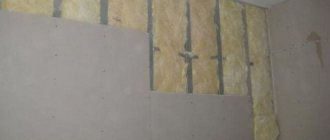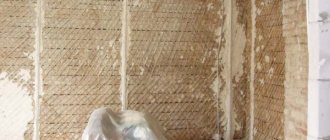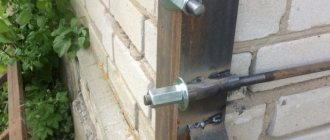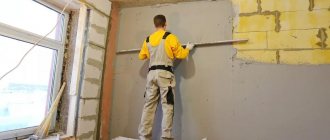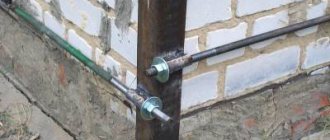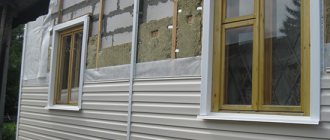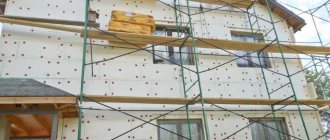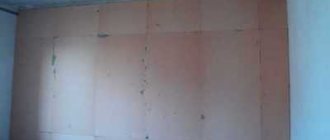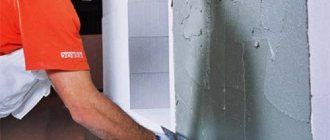Concrete coatings are used in a variety of areas: when installing floors, concreting surfaces in both industrial and residential buildings, constructing highways and much more. However, concrete has a low tensile strength, so during the hardening process the mixture contracts slightly and shrinkage of the structures occurs. Because of this, minor and more serious defects appear on the surface. In this case, sealing of cracks in concrete is required, which is performed using different technologies depending on the type of damage and the cause of its occurrence.
Types of cracks in concrete
Some novice or unscrupulous builders prefer to simply cover up a hole or any other defect with putty or mortar. However, before you repair a hole or crack in a concrete wall or other foundations, it is worth understanding what exactly caused such troubles to occur.
There are several types of defects:
- Superficial. Such cracks often appear after pouring the foundation during the drying of the sand-cement mortar, if the mixture was prepared without observing the required proportions of the components, low-quality components were used, or there was not enough water in the mixture.
- Shrinkage cracks (also called hairline cracks). Defects of this type are considered the most dangerous, since they cause not only deformation of the fundamental foundation, but also the entire building as a whole. This leads to a decrease in strength. Defects of this type appear when there is an uneven load on the foundation and when the cement composition is incorrectly selected.
- Temperature-shrinkable. Cracks of this type appear during the hardening process of the concrete base due to the exothermic reaction occurring between cement and water. Very often, when constructing walls and ceilings, novice builders do not take into account the freedom of deformation, as a result of which temperature stress occurs in the concrete mass and defects appear on the surface.
- Cracks and holes appearing due to poor quality reinforcement. If the frame for strengthening the structure is too weak, it will bend under loads, which will also lead to the formation of defects. In addition, the reinforcing rods may begin to oxidize. Due to corrosion, the material increases in size, tearing the concrete mass from the inside.
Concrete surfaces located outdoors are also susceptible to cracking. The external environment contains chemically active substances that create favorable conditions for the appearance of defects.
In addition, sharp temperature changes, which can occur both on the surface and in the thickness of the concrete, have a destructive effect. In this case, not only cold air, but also ultraviolet radiation has a detrimental effect.
It is also worth paying attention to the width of the cracks, since in some cases such defects are not critical.
Cracking in walls and its causes. A case from our practice
Some problems that are associated with the reliability of certain buildings sometimes cause panic attacks in people. Such situations happen quite often, and one of them was voiced by the owner of an apartment in an old 9-story panel building:
We live on the 5th floor and both of our 2 rooms share an external wall. It is she who causes us great fear. We regularly hear clicks and crackling sounds, and this is especially noticeable at night. This situation has been going on for several months now, and now the appearance of strange sounds has become more frequent (it’s summer). There are no visible cracks in the wall. We are wondering whether it is worth continuing to live in our apartment or whether it is time to change our location before it is too late.
Acceptable crack sizes
In the construction industry there is such a definition as the permissible crack opening width, which is determined according to DBN V.2.6-98:2009 based on operating conditions:
- The crack size should not exceed 0.5 mm if the concrete surface is not exposed to weather conditions. That is, it is not affected by moisture, low temperatures and ultraviolet radiation.
- The permissible crack opening width cannot be more than 0.4 mm, provided that the structure is exposed to weather influences.
- The width of the crack should not exceed 0.3 mm if the concrete base is located in an aggressive environment.
- It is not recommended to allow the formation of gaps larger than 0.2 mm when we are talking about reinforced structures that are characterized by reduced resistance to corrosion.
Horizontal cracks with a small opening, which often appear in reinforced concrete columns, are also considered harmless.
However, it is important to take into account that there are certain operating conditions under which cracking is not allowed at all:
- if we are talking about reinforced concrete structures that constantly interact with liquids and gases (that is, they must be impenetrable and airtight);
- when using structures that are subject to more stringent requirements for their durability.
Having determined the type of defect and the need to correct it, it is much easier to choose than to repair holes in a wall or any other concrete surface.
What if the problem is not in the panel seams?
If during the audit no problems were found with the joints of the slabs, the cause of the sounds may be due to thermal expansion of reinforced concrete structures and their further sudden cooling. However, this is certainly not so easy to determine. It is likely that certain construction standards were violated during the construction of the house. In this case, it is worth protecting the wall from possible temperature changes, and the ideal way for this would be external thermal insulation. With her, the apartment will be warm in winter and cool in summer.
Cement mortars
These compounds are very popular due to their low cost and ability to repair minor shrinkage cracks in concrete.
Repairing a crack
Before you begin sealing, you need to check the crack itself for chips around it. If there are any, then in the near future they may turn into holes, so it is imperative to remove all peeling pieces of concrete. After this you need:
- Perform jointing. To do this, using a chisel and a hammer, you need to walk along the entire length of the crack so that its depth is at least 5 mm. If necessary, you can use a spatula to create a depression.
- Remove dust using a vacuum cleaner and rinse the resulting depression with water.
- Remove excess water and cover the crack with cement mortar (3 parts sand to 1 part cement with the addition of PVA). In this case, you need to ensure that the composition covers the entire space of the recess.
- Moisten the poured cement with water.
Filling the hole
If a hole has formed in the concrete surface in which the reinforcement is visible, the defect can be repaired as follows:
- Clean the hole in the concrete and treat its surface with an anti-corrosion compound.
- Place pieces of steel wire about 4 mm in diameter into the recess.
- After this, the recess is covered with a primer, applying it evenly over the entire surface. In this case, the thickness of the mixture layer should be about 3 mm.
- Without waiting for the mixture to dry, fill the hole with a cement compound for sealing cracks in concrete and make sure that it fills the entire hole. If the hole is too deep, then cement is poured in several stages. In this case, each subsequent layer must be moistened with water from a spray bottle.
- Level the surface with a lath (metal or wood), moving the tool from right to left.
- After the mixture has hardened, excess cement composition must be removed with a spatula and the surface must be plastered. If the crack was too deep, then leveling is done using a grinding machine.
Healthy! The cement composition must be poured with a reserve so that it is slightly higher than the floor surface. The mixture will shrink as it hardens.
After 24 hours, the concrete floor can be painted or any finishing material can be laid on it.
However, it is worth considering that such sealing of cracks in concrete will not provide a sealing effect and is not suitable for surfaces that have increased waterproofing requirements. In addition, the cement composition can be considered as a temporary solution to problems. Sooner or later the defects will appear again. If you want to “overhaul” the holes and avoid their occurrence in the future, then in this case you can repair the defects using resins, specialized repair compounds based on them, or sealant.
Strengthening walls
In construction practice, the most dangerous phenomenon is when a crack grows. What to do in this case: rebuild the damaged area again or seek help from a professional construction organization?
ATTENTION! If the panel ceiling needs to be repaired, specialists will repair the damage.
The wrapping process is not complicated, but this procedure has a number of nuances, without which it is impossible to talk about the quality of the work done. Stages of repair work:
- Install steel outer corners with shelves (at least 10 cm) at the outer corners.
- At the top and bottom, on crutches, several smooth reinforcing lines are laid.
- The rods are threaded and welded to the previously installed corners. Before welding, screw the nuts onto the formed threads of the rods.
- At a distance of 1 m, on the side of the rods, rods are welded, which serve to transmit torque. Next, after the tie has been made using ordinary wrenches, two specialists should simultaneously begin to twist the rods, gradually increasing the tension.
To strengthen the wall, problem areas are subject to reinforcement. This operation is performed using steel mesh or carbon fiber reinforcement material.
In some cases, it is impossible to do without additional fastening of anchors and metal frames, as well as embedded elements (reinforcement) in the grooves. When strengthening the wall of a panel house, the injection method can also become indispensable.
Long-term repair of defects
When deciding how to repair cracks in concrete for a long time, you should pay attention to this method of treating defects. Resin and sealing mixtures based on it are suitable for restoring screeds, blind areas and various concreted areas or horizontal surfaces.
Repairing cracks in concrete using such compounds has a number of advantages. First of all, this is the low cost of the mixtures, as well as their quick drying. On the other hand, the resin allows you to securely fix the seams and keep them from subsequent enlargement.
So, to eliminate defects you will need to prepare:
- angle grinder and diamond-coated discs;
- vacuum cleaner;
- spatulas and a trough for diluting the composition;
- primer composition for concrete;
- Epoxy (base A and hardener B);
- Fine-grained sifted sand.
Before you repair a crack, you need to clean it of dust and dirt. After this, we carry out the sealing in the following sequence:
- We repair the crack. In this case, the width of the resulting recess must be at least 5 mm.
- Using a grinding machine, we cut transverse seams in the concrete in increments of 400 mm (the length of the grooves is about 100-150 mm).
- We remove the loose layer of concrete and remove dust from the surface using a vacuum cleaner.
- We treat the surface of the defect with a primer, and fix the transverse grooves using repair brackets.
- We prepare a solution from resin (base), hardener and sand according to the instructions on the packaging with the composition.
- We fill the defect with the resulting mixture and quickly level the surface, since the setting time of the resin is only 10 minutes.
After this, it is recommended to fill the surface with sand, which will need to be removed with a vacuum cleaner before plastering the base or covering it with finishing material.
The best epoxy compounds
If we talk about the best materials for repairing cracks in concrete walls and other surfaces, the most effective today are considered to be:
- Domestic epoxy resin ED-16 and ED-20 costs about 2,000 per 3 kg. The hardener will have to be purchased separately (costs about 300-500 rubles).
- Epoxy 520 resin from the Czech manufacturer Spolchemie costs 3,500 rubles per 5 kg.
- German composition UZIN KR 416, which will cost 2,700 rubles per 0.75 kg.
Also very popular are compositions from the Italian manufacturer Sika.
However, it is worth considering that this method of correcting defects is not suitable for treating holes that form in concrete foundations under strong pressure from water. In this case, it is worth using a sealant.
Causes of cod
It's quite simple. The problem lies in the interpanel seams, which are the weak point of such houses. As for the sounds themselves, they become stronger with a sharp temperature change, which can be observed in the summer. The walls get very hot in the sun during the day and cool down quickly at night. In such a situation, we can say with 90% confidence that the interpanel seam has exhausted its service life and has collapsed.
The cause of cracking in the walls can also be a slight movement of the panels that are connected to each other by welding. To find out exactly what is causing the unpleasant sounds, it is better to immediately call industrial climbers to inspect the wall. If the problem lies in the seams, it is necessary to seal them and restore them to their original condition. You will have to pay a lot for this, but now you can sleep peacefully.
Use of sealants and self-expanding tapes
It’s worth saying right away that this method of sealing defects is very expensive, so it is most often used when repairing concrete bowls of country pools. However, despite its high cost, the use of sealant and self-expanding cords has its own advantages:
- the ability to process any type of defect;
- complete tightness;
- the ability to carry out installation work in cold weather conditions.
To work, in addition to the standard set of tools, you will need:
- mounting gun;
- self-expanding tape or cord;
- chisel and brushes;
- sealant for concrete.
However, before covering up the flaw, you need to measure the dimensions of the cracks and purchase the right type of sealant and tapes depending on this. For example, if the hole depth is 60 mm, then an 18 x 23 mm cord will do.
The next step is necessary:
- Expand the cracks and remove dust.
- Install the cord into the recess.
- Fill the remaining space with sealant.
- Smooth out the protruding compound using a spatula.
After completing the work, you won’t have to guess how to putty the surface or caulk it. It is enough just to apply the composition and smooth it out.
If we talk about the best compositions of this type, the most popular are:
- Domestic ELASTOSIL PU 20 costs 280 rubles per 600 ml.
- The composition is from the French manufacturer Rubberflex, which today sells for 300 rubles per 310 ml.
- PLOW tape made in Russia costs about 260 rubles per linear meter.
Injection
Also, when deciding how to seal holes in a concrete wall in the most effective way, especially if not only a crack has appeared, but also water is flowing through it, you should pay attention to this method.
Injection technology involves introducing a special composition (polyurethane or epoxy resin, microcement or waterproofing mixture) into the thickness of concrete using special injection pumps that create strong pressure.
To perform such restoration of defects it is necessary:
- Make holes in a staggered pattern on both sides of the gap.
- Install packers in them (special tubes through which the solution is supplied, reminiscent of a dowel) at an angle.
- Pour in the solution.
- Pull out the tubes and cover the surface with the building compound.
So, we looked at how to fix a hole in a concrete wall yourself, but what if we are talking about aerated concrete?
Features of sealing cracks in aerated concrete
Cracks form in aerated concrete as often as in conventional cement-sand monoliths. To seal them, work is performed in the following sequence:
- A layer of destroyed building material is removed from a wall or any other aerated concrete surface and cleaned of dust and dirt.
- The gap is primed. To do this, it is recommended to use a 50% aqueous dispersion of PVA and water (1:3 ratio).
- Cracks are sealed depending on their size. If the damage is single and its width does not exceed 0.4 mm, then the gap is widened to 10 mm and any building compound is poured into it (you can use cement or special adhesive for aerated concrete). If the width of the defect is up to 10 mm, then it is better to use a porous adhesive composition for sealing and widen the gap to 20 mm. If a defect up to 20 mm wide appears, it is recommended to use an adhesive or cement composition, after adding coarse crushed stone from aerated concrete.
After completing the work, it is necessary to cover the treated surface with a sheet of plywood (secure with self-tapping screws) for 3-5 hours.
